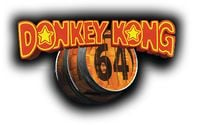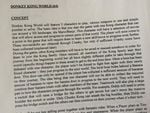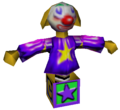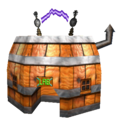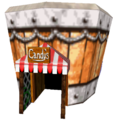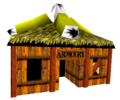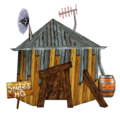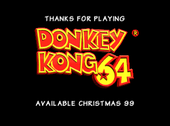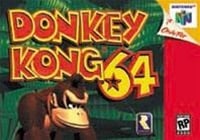List of Donkey Kong 64 pre-release and unused content
From the Super Mario Wiki, the Mario encyclopedia
Jump to navigationJump to search
This is a list of pre-release and unused content for the game Donkey Kong 64.
Pre-release elements
Early ideas
- The game was named "Donkey Kong World" in its pitch document[1]. The document mentions the existence of "Cranky coins" used to purchase new moves and skills, a function served by Banana Bunch Coins in the final game.
- In volume 104 of Nintendo Power, in which Daniel Owsen answered a question from a fan regarding a Donkey Kong Country game for the Nintendo 64, he stated that a listing for "Ultra Donkey Kong" appeared on some unnamed Japanese magazines, albeit without an official announcement.[2] It was even proposed to be for the ill-fated Nintendo 64DD.[3]
Early builds
General
- The game was originally intended to use up to 4 megabytes, but a bug caused this build to randomly crash. Unable to locate the glitch, Rare decided to increase the cartridge size and bundle the N64 Expansion Pak as a quick fix.[4]
- Early screenshots of Donkey Kong 64 showed that DK's Tree House originally had a shower stall in it with a poster of Banjo and Kazooie on it. Also, the boss Mad Jack was originally known as "Junk-in-the-Box" and was also drastically different in appearance. He was also originally a mini-boss fought by Tiny Kong[5] in the R&D Room in Frantic Factory instead of being a full boss fought at the area's end. The Toy Monster is the mini-boss in the final version, and it is fought by Chunky Kong.
- The weapons the Kongs wielded in earlier builds looked like real-world firearms instead of the wooded, cartoonish ones seen in the final version of the game.[6] Donkey Kong's Coconut Shooter resembled a double-barreled shotgun while Diddy Kong's Peanut Popguns resembled actual pistols, and reportedly shot bullets with realistic sound effects. The stylization to cartoonish weapons was soon suggested by Shigeru Miyamoto during a test build session by creative director George Andreas,[7] who indicated that it was initially a placeholder that he had simply gotten used to in development.[8]
- Several enemies were dropped from the game, including a Re-Koil, a vulture, an insect, a robotic fish, an armadillo (possibly Army), and two variants of a Jack-in-the-Box like enemy, one as a clown and another with a boxing glove.
- Cranky's Lab, Candy's Music Shop, Funky's Store and Snide's HQ all looked slightly different in the pre-release version compared to the final version.
- By using the glitch to obtain the fifth Boss Key in Angry Aztec and then enter Troff and Scoff's room again, the player can see that the boss door has the DK logo with a green checkmark over it, indicating that the boss has been beaten.
- A golden Banana Bunch appears as the early HUD icon for the Golden Banana in the kiosk demo; it appears if players win Diddy Kong's Mine Cart mini-game. A single frame of the icon appears in the final game, as the emblem on B. Locker's head.
The shower stall and Banjo and Kazooie poster originally found in DK's Tree House in Donkey Kong 64.
Junk-in-the-Box, what Mad Jack looked like before Donkey Kong 64 was fully completed.
The unused armadillo enemy, resembling an Army.
Unused model of a Re-Koil.
Early model of Cranky's Lab.
Early model of Candy's Music Shop.
Early model of Funky's Store.
Early model of Snide's HQ.
Not For Resale demo cartridge
A demo cartridge was produced to exhibit the game in retail stores. It contains the second Dogadon fight, the Mine Cart-riding sequence in Jungle Japes and a boss fight with Army Dillo. This demo features a few differences from the final build [9][10].
Text and interface
- Squawks dialogue after completing the Mine cart minigame is different and shorter.
Audio
- Dogadon has a different sound effect for his spitting attack. The sound effect is used by the Llama in the final version, when Donkey Kong wakes him up inside the Llama's Temple to cool the pool of lava.
- The theme played after defeating a boss is different from the final build.
- Army Dillo has a different voice and several fully acted lines cut from the final version.
Gameplay
- A counter for a silver Balloon item (which act as an extra life) appears to the left of the life counter. The balloon cannot be collected through the normal course of the demo, but it is present in a debug room left on the cartridge [11].
- For the Mine cart minigame, the player has to collect 70 coins rather than 50 as in the final version.
- Though fought in Jungle Japes, Army Dillo has the same attack patterns as the Crystal Caves rematch in the final build.
Box art
- The game's original box art before being released depicted only Donkey Kong in a jungle background before being replaced with a group picture of all five Kongs riding on the minecart with King K. Rool in the background. However, the cartridge artwork still retains the original prototype box art.
Unused content
- Using a GameShark code to give the Kongs infinite health will reveal a fourth melon that will be retained when the code is disabled. This means that at one point, either the Kongs were supposed to get a fourth melon from Candy Kong at some point, or they were supposed to start with two melons instead of just one.
- In the Mystery Menu, under Bosses, there is an unused "The Main Event" option that can be used to refight King K. Rool. This was most likely taken out because the player can refight K. Rool in-game.
- A "dogpaddling" animation exists for Rambi the Rhino. Since it is impossible for him to get into water in the final game, this goes unused.
- King Kutout has an unused fourth phase; exactly what it was intended to be is unclear.
- As the result of him only being playable in multiplayer, Krusha has multiple unused animations, most of which appear to be recycled from Chunky.
- The timer graphic can display numbers higher than 99, but this is only seen in the unused bonus levels below. In the final game, all events with a timer of more than 99 seconds use an alternate timer graphic.
Unused text
- An unused line of menu text reads "Ice Key", which can be seen in the pause menu via a Gameshark code. The Ice Key is one of the elusive Stop 'N' Swop items from Rareware's earlier title Banjo-Kazooie, which suggests that Donkey Kong 64 was originally intended to be compatible with the feature.[12]
- An unused piece of dialogue from the Seal mentions paying 100 "skulltilleys" to race him, a portmanteau of Carl Tilley (a Rare developer) and Skulltula (an object found in The Legend of Zelda: Ocarina of Time). The French translation replaced this with a reference to Objectif Nul, a then-popular comedy.
- B. Locker has unused lines suggesting a very different personality for him than what he has in the final game. The Golden Bananas were apparently supposed to be a bribe for him, and if the Kongs obtained enough, he'd let them "sneak in" to the level.
Unused graphics
- The boot-up sequence of the computer in Frantic Factory that turns on the big machine in the Production Room has an extra image that says "MAKING" with a picture of a robot.
- The main menu's font has icons for every N64 controller button. However, only the
 ,
,  , and
, and  buttons are actually used.
buttons are actually used. - The HUD also has an icon for the
button, which is never used in the game for any reason.
Unused sounds
- Tiny Kong has an unused soundbyte, intended to play whenever she throws a barrel, but she does not interact with any barrels in the final game unless one exploits a glitch to allow her to be used in the Army Dillo and Dogadon boss fights.
- The soundbyte that plays when Lanky Kong picks up a barrel is technically used, in the final battle against K. Rool; however, it's very hard to hear due to the crowd ambience and the clanging noise made by K. Rool as he fumbles around the boxing ring with a spotlight on his head.
Unused bonus levels
- An exact copy of the Gloomy Galleon version of Stealthy Snoop, but without the intro text, exists, possibly suggesting that Stealthy Snoop was one of the bonus levels that could be replayed at Snide's.[13]
- Two Mad Maze Maul levels. One has a timer of 120 seconds where a Kong must hit 11 enemies, and the other has a timer of 125 with a hit counter of 10. Most notably, the former one has Zingers, Klobbers, and a Klump in it.[13]
- Three instances of Stash Snatch. The first has 16 coins, the second has just four but a 120-second timer and Stealthy Snoop's mechanics (but not the music), and the third has a 120-second timer, 33 coins, and Klobbers. Since the bonus level music doesn't loop, the latter two levels have 60 seconds of dead silence in them.[13]
- An instance of Splish Splash Salvage with 15 coins.[13]
- An instance of Speedy Swing Sortie with a 60-second timer and six coins, but heavy use of Zingers.[13]
- An instance of Peril Path Panic with 12 Banana Fairies that need to be saved. (For comparison, the version of the game at Snide's, intended to be the hardest, only has 10.)[13]
References
- ^ Makin, Nic (May 7, 2015). Twitter post. Retrieved May 13, 2015.
- ^ Owsen, Dan (January 1998). Nintendo Power volume 104, "Insider Collector's Edition". Page 16.
- ^ http://www.ign.com/articles/1997/07/26/donkey-kong-swings-to-64dd
- ^ Commentary playthrough of Conker's Bad Fur Day by several Rare developers.
- ^ Tiny's hint from Wrinkly for Frantic Factory:"Cranky can help Tiny beat the giant springy box."
- ^ Promotional footage of the game included in an issue of the Spanish gaming magazine Hobby Consolas. Retrieved November 12, 2014
- ^ Retro Gamer #84, pg. 36
- ^ Power, Tom (December 6, 2019). As Donkey Kong 64 turns 20, the devs reflect on its design, the infamous DK Rap, and how a shocked Shigeru Miyamoto created the Coconut Shooter. GamesRadar+. Retrieved December 6, 2019.
- ^ Micro 64 Writeup
- ^ Playthrough of the demo
- ^ Video of the kiosk's build debug rooms
- ^ Video of the Ice Key text in the game, along with a theory as to where it could have been used in Donkey Kong 64.
- ^ a b c d e f "Donkey Kong 64 - Unused Bonus Games" on YouTube. Uploaded November 10, 2013. Retrieved August 26, 2020.
